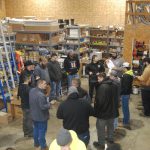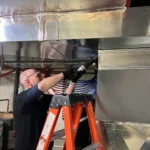Maintaining good indoor air quality (IAQ) is essential for a healthy and comfortable living environment. With people spending more time indoors, the air we breathe inside our homes has a significant impact on our well-being. Poor air quality can lead to a range of health problems, from allergies to respiratory issues. Thankfully, your HVAC system can be enhanced with HVAC upgrades to improve indoor air quality and create a cleaner, healthier home environment.
Understanding the Importance of Indoor Air Quality
Indoor air quality is often overlooked, but it plays a critical role in your health. Polluted indoor air can contain dust, allergens, pet dander, mold spores, and even harmful chemicals like volatile organic compounds (VOCs). Prolonged exposure to these pollutants can aggravate respiratory conditions, cause headaches, and weaken the immune system. Therefore, taking steps to improve IAQ is vital for maintaining a healthy home.
Health Impacts of Poor Indoor Air Quality
Poor indoor air quality can have both immediate and long-term health effects. In the short term, it may cause symptoms like sneezing, coughing, and eye irritation. Over time, exposure to airborne pollutants can contribute to chronic conditions such as asthma, bronchitis, or heart disease. Children, the elderly, and individuals with preexisting respiratory issues are particularly vulnerable to the effects of poor air quality.
The Role of Your HVAC System in Air Quality
Your HVAC system does more than just regulate temperature—it also plays a key role in air circulation and filtration. Every time your system runs, it draws air from your home, filters it, and redistributes it back into the living space. If your HVAC system isn’t properly maintained or upgraded, it can circulate contaminants throughout your home. On the other hand, HVAC upgrades can significantly improve the quality of the air you breathe.
How HVAC Systems Affect Air Circulation
Air circulation within your home is vital to maintaining good IAQ. A properly functioning HVAC system ensures that fresh air is consistently brought in and stale air is expelled. However, if your system lacks adequate filtration or ventilation capabilities, it may end up recirculating pollutants, contributing to poor indoor air quality.
Signs That Your Indoor Air Quality Needs Improvement
Several warning signs may indicate your indoor air quality needs improvement. These include persistent odors, visible dust accumulation, increased allergy symptoms, or frequent headaches and respiratory discomfort. If you notice any of these symptoms, it’s time to consider HVAC upgrades to improve air quality.
Common Symptoms of Poor Air Quality
Common symptoms associated with poor indoor air quality include coughing, sneezing, sinus congestion, eye irritation, and fatigue. If these issues are more pronounced when you are at home and subside when you leave, your home’s air quality may be the cause. Dry skin, worsening asthma symptoms, and frequent illnesses are also signs that your air could be polluted.
Upgrading HVAC Filters
One of the easiest and most effective ways to improve indoor air quality is by upgrading your HVAC filters. Standard filters trap larger particles like dust, but high-efficiency filters are designed to capture smaller pollutants, such as mold spores, pet dander, and pollen. These HVAC upgrades provide better protection and help ensure cleaner air throughout your home.
High-Efficiency Filters: MERV Ratings Explained
The efficiency of HVAC filters is measured by a MERV (Minimum Efficiency Reporting Value) rating. The higher the MERV rating, the more effective the filter is at capturing smaller particles. For optimal air quality, consider filters with a MERV rating of 13 or higher. These filters can trap finer particles, improving the air you breathe. However, it’s important to check that your HVAC system can handle a higher-rated filter, as dense filters may restrict airflow if the system isn’t compatible.
Air Purifiers and HVAC Systems
Integrating air purifiers into your HVAC system is another excellent way to enhance indoor air quality. These devices work by filtering out harmful particles, such as viruses, bacteria, and VOCs, from the air before it’s circulated throughout your home. Whole-house air purifiers are particularly effective, as they clean the air in every room served by your HVAC system.
Integrating Air Purifiers with Your Existing System
Air purifiers can be installed directly into your HVAC system, ensuring that all air passing through the system is cleaned. These purifiers use advanced filtration technologies, such as HEPA filters or activated carbon, to remove even the smallest airborne pollutants. This is an ideal solution for households with allergy sufferers or those living in areas with high pollution levels.
Using UV Light Systems for Air Sanitization
UV light systems are another powerful tool for improving indoor air quality. Ultraviolet (UV) light has been proven to kill bacteria, viruses, and mold spores, preventing them from circulating through your home. Installing a UV light system in your HVAC unit can help sterilize the air as it passes through the system.
How UV Lights Kill Airborne Pathogens
UV light works by disrupting the DNA of microorganisms, rendering them unable to reproduce or cause infections. By placing a UV light near the coils and ducts in your HVAC system, you can ensure that these pathogens are destroyed before they can enter your home’s air supply. This method is particularly beneficial in homes where residents suffer from allergies or respiratory conditions.
Ventilation Upgrades for Fresh Air Intake
Ventilation is essential for maintaining fresh, clean air in your home. Many homes are tightly sealed to improve energy efficiency, but this can also trap pollutants inside. By upgrading your HVAC system’s ventilation, you can introduce more fresh air into your home while still maintaining energy efficiency.
Improving Ventilation with Energy Recovery Ventilators (ERVs)
Energy recovery ventilators (ERVs) are a great solution for improving ventilation without sacrificing energy efficiency. ERVs work by exchanging stale indoor air with fresh outdoor air, while also transferring heat and moisture between the two airflows. This keeps your home well-ventilated while minimizing energy loss.
Humidifiers and Dehumidifiers for Balanced Moisture
Maintaining the right humidity level in your home is key to good indoor air quality. Too much moisture can lead to mold growth, while air that is too dry can cause respiratory irritation. Installing a humidifier or dehumidifier as part of your HVAC upgrades helps keep the air in your home balanced and healthy.
Managing Humidity Levels for Better Air Quality
Ideal indoor humidity levels range between 30% and 50%. A humidifier adds moisture to the air during dry months, while a dehumidifier removes excess moisture during humid months. Balancing moisture not only makes the air more comfortable to breathe but also reduces the risk of mold and dust mites thriving in your home.
Duct Cleaning and Maintenance
Dirty ducts can harbor dust, allergens, and other pollutants that degrade indoor air quality. Regular duct cleaning and maintenance can prevent the buildup of contaminants, ensuring that only clean air is circulated through your home.
The Importance of Clean Ductwork in Air Quality
Over time, ducts can become clogged with dust, pet dander, and even mold. These pollutants are then blown into your living spaces whenever your HVAC system runs. Regular cleaning of your ductwork can significantly improve the quality of the air in your home, especially if you’ve recently completed renovations or have pets.
Sealing Duct Leaks for Improved Efficiency
Leaky ducts not only reduce the efficiency of your HVAC system but also allow pollutants from attics, basements, or crawlspaces to enter your home’s air. Sealing duct leaks can prevent this contamination and improve both indoor air quality and energy efficiency.
How Leaky Ducts Contribute to Poor Air Quality
When air leaks from ducts, it draws in unfiltered air from unconditioned spaces. This unfiltered air can contain dust, mold, or chemical fumes, all of which reduce the quality of your indoor air. Sealing leaks ensures that all air passing through the ducts is properly filtered and conditioned before reaching your living areas.
Smart Thermostats and Air Quality Monitoring
Modern smart thermostats do more than just control temperature—they can also help monitor and improve indoor air quality. Some models are equipped with sensors that measure humidity, air purity, and even CO2 levels, allowing you to track and adjust the air quality in your home.
How Modern Thermostats Can Help Monitor Air Quality
Smart thermostats can alert you when your home’s air quality is compromised, enabling you to take action by adjusting ventilation settings, activating air purifiers, or scheduling maintenance. This technology offers a convenient way to stay on top of your home’s air quality without constantly monitoring it manually.
Zoned HVAC Systems for Better Air Control
Zoned HVAC systems allow you to control the temperature and air quality in specific areas of your home. By dividing your home into different zones, you can focus your HVAC system’s efforts where they’re needed most, improving both comfort and indoor air quality.
Controlling Air Quality in Different Areas of Your Home
With a zoned system, you can set different temperature and air filtration settings for each area of your home. This is particularly useful for larger homes or homes with varying air quality needs, such as separating pet areas from bedrooms. Zoned systems help ensure that every area of your home has the appropriate level of ventilation and air purification.
Regular HVAC Maintenance
Routine HVAC maintenance is essential for ensuring that your system continues to provide clean, high-quality air. Simple tasks like changing filters, cleaning coils, and inspecting ducts can make a significant difference in your home’s air quality.
The Role of Routine Maintenance in Maintaining Air Quality
Regularly servicing your HVAC system prevents dust, debris, and pollutants from accumulating in your system and circulating through your home. Scheduling annual maintenance with a professional technician ensures that your system is functioning properly and providing the best possible air quality for your household.
When to Call a Professional
If you’ve noticed persistent air quality issues despite your best efforts, it may be time to call in a professional. An HVAC expert can assess your system, recommend the necessary HVAC upgrades, and ensure that your home’s air is as clean and safe as possible.
Knowing When You Need Expert Help for Air Quality Issues
A professional can identify underlying problems, such as mold growth, improperly sized filters, or ventilation issues, that could be affecting your home’s air quality. Don’t hesitate to reach out to an HVAC technician if your family is experiencing ongoing health issues or discomfort related to indoor air.
The Long-Term Benefits of HVAC Upgrades
Upgrading your HVAC system for better indoor air quality offers long-term benefits. Beyond immediate improvements in air quality, these HVAC upgrades can lead to enhanced comfort, reduced health risks, and lower energy costs. A healthy home environment not only supports your physical well-being but also contributes to better overall quality of life.
Health, Comfort, and Energy Savings
By investing in HVAC upgrades that improve indoor air quality, you create a healthier home for your family while enjoying increased comfort and energy savings. These upgrades ensure that your system runs efficiently, reducing your carbon footprint and energy bills. Ultimately, HVAC upgrades are an investment in both your home’s air quality and your family’s long-term health.







